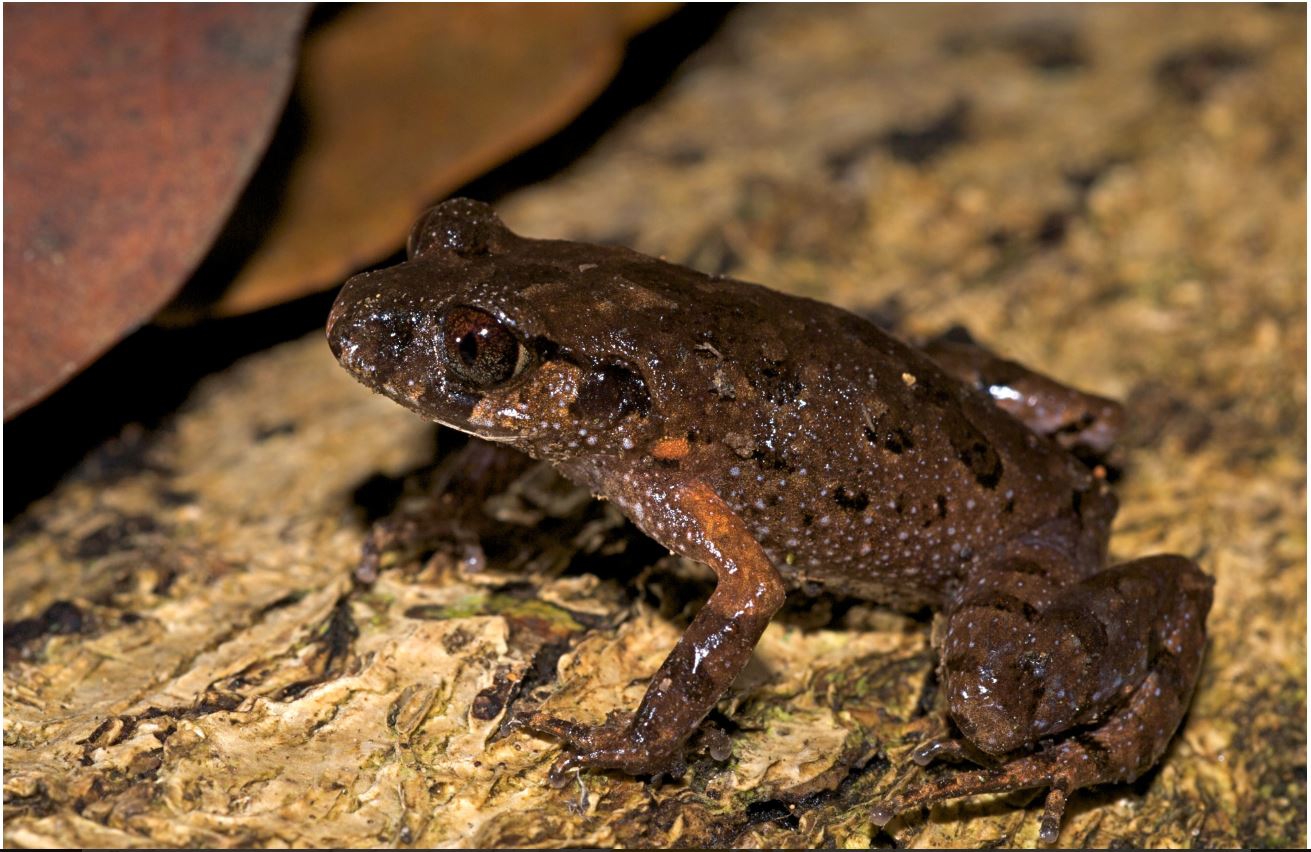| Citation |
IUCN SSC Amphibian Specialist Group 2015. Leptolalax bidoupensis. The IUCN Red List of Threatened Species 2015: e.T48101579A48101583. http://dx.doi.org/10.2305/IUCN.UK.2015-2.RLTS.T48101579A48101583.en. Downloaded on 09 May 2019. |
Description |
Geographic Range
NATIVE
Extant (resident)
Viet Nam
NUMBER OF LOCATIONS
3
UPPER ELEVATION LIMIT
1,730 metres
LOWER ELEVATION LIMIT
1,620 metres
UPPER DEPTH LIMIT
LOWER DEPTH LIMIT
Geographic Range in detail
ESTIMATED AREA OF OCCUPANCY (AOO) (KM²)
10-214
CONTINUING DECLINE IN AREA OF OCCUPANCY (AOO)
EXTREME FLUCTUATIONS IN AREA OF OCCUPANCY (AOO)
ESTIMATED EXTENT OF OCCURRENCE (EOO) (KM²)
214.03
CONTINUING DECLINE IN EXTENT OF OCCURRENCE (EOO)
EXTREME FLUCTUATIONS IN EXTENT OF OCCURRENCE (EOO)
CONTINUING DECLINE IN NUMBER OF LOCATIONS
Unknown
EXTREME FLUCTUATIONS IN THE NUMBER OF LOCATIONS
RANGE DESCRIPTION
This species is currently known from a very narrow elevation range (1,620-1,730 m asl) in Bidoup Nui Ba National Park, Lam Dong Province in Viet Nam. The distribution of this species likely extends to adjacent areas in the Langbian Plateau, including Chu Yang Sin National Park and Phuoc Binh National Park (in Dak Lak and Ninh Thuan Provinces) (Rowley et al. 2011) and its range map includes suitable habitat contiguous with the species known localities. Further surveys in these areas are warranted to determine its presence there and to extend its known elevation limits. The species extent of occurrence (EOO) is 214 km². This likely represents three threat-defined locations and thus to current knowledge the population is geographically restricted.
Population
CURRENT POPULATION TREND
Decreasing
NUMBER OF MATURE INDIVIDUALS
POPULATION SEVERELY FRAGMENTED
CONTINUING DECLINE OF MATURE INDIVIDUALS
Population in detail
Habitat and Ecology
SYSTEM
Terrestrial, Freshwater (=Inland waters)
HABITAT TYPE
Forest, Wetlands (inland)
GENERATION LENGTH (YEARS)
CONGREGATORY
MOVEMENT PATTERNS
CONTINUING DECLINE IN AREA, EXTENT AND/OR QUALITY OF HABITAT
Yes
Habitat and Ecology in detail
HABITAT AND ECOLOGY
This species is associated with swampy areas adjacent to fast-flowing rocky streams and rocky seeps adjacent to streams within montane evergreen forest. Despite the only known locality being within a protected area, habitat in the area is being increasingly modified (Le 2011). Calling has been detected in May and June (Rowley et al. unpubl. data), and metamorphs have been seen toward the end of May (Rowley et al. 2011). Eggs and larvae of this species are unknown, however it likely has a free-swimming larval stage like all other Leptolalax species for which larvae are known (J. Rowley pers. comm., February 2015).
CLASSIFICATION SCHEME
Habitats Suitability Major importance
1. Forest 1.9. Forest - Subtropical/Tropical Moist Montane Suitable Yes
5. Wetlands (inland) 5.1. Wetlands (inland) - Permanent Rivers/Streams/Creeks (includes waterfalls) Suitable Yes
5.7. Wetlands (inland) - Permanent Freshwater Marshes/Pools (under 8ha) Suitable Yes
Threats
Agriculture & aquaculture
Marine & freshwater aquaculture
Transportation & service corridors
Roads & railroads
Biological resource use
Logging & wood harvesting
Threats in detail
THREATS
The species elevation restrictions may be quite narrow (Rowley et al. 2011). This may leave it susceptible to restriction of suitable habitat which, in the protected area where it is found, is becoming increasingly modified and fragmented due to anthropogenic processes including the construction of roads, subsistence logging and a salmon farm (Le 2011, J. Rowley pers. comm. February 2014).
CLASSIFICATION SCHEME
Threats Timing Stresses Scope Severity Impact score Invasive species Virus
2. Agriculture & aquaculture 2.4. Marine & freshwater aquaculture 2.4.2. Industrial aquaculture Ongoing
1. Ecosystem stresses 1.1. Ecosystem conversion
1.2. Ecosystem degradation
2. Species Stresses 2.2. Species disturbance
2.3. Indirect species effects 2.3.7. Reduced reproductive success
Minority (<50%) Unknown Unknown
4. Transportation & service corridors 4.1. Roads & railroads Ongoing
1. Ecosystem stresses 1.1. Ecosystem conversion
1.2. Ecosystem degradation
2. Species Stresses 2.1. Species mortality
2.2. Species disturbance
2.3. Indirect species effects 2.3.7. Reduced reproductive success
Unknown Unknown Unknown
5. Biological resource use 5.3. Logging & wood harvesting 5.3.1. Intentional use: (subsistence/small scale) [harvest] Ongoing
1. Ecosystem stresses 1.2. Ecosystem degradation
2. Species Stresses 2.1. Species mortality
2.2. Species disturbance
2.3. Indirect species effects 2.3.7. Reduced reproductive success |

